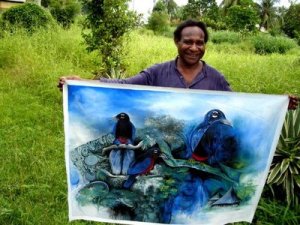The climate of
Goroka was spring like all year around and as a result there was always and abundance of fresh vegetables to be found in the local market.
Being a central location the market was also the place to pick up a PMV (Passenger Motor Vehicle) for a trip further up or down the
Highlands Highway. While some of these were vans, many were open decked ISUZU trucks.
The Saturday market was one of the best and all of the activity took place in a designated area. The first vendors could use the concrete slab tables and many preferred to set up on ground mats or the ubiquitous blue tarpaulins that were used for drying coffee.
 |
Kau Kau - Goroka Market
Photo: Roger Smith |
The local street potato was kau kau and somewhat coarser version of the New Zealand native tuber, the kumara. Kau kau along with sago was a staple in the diet but this was supplemented with green leaf vegetables.
There were small piles of cabbages, broccoli and cauliflower in season. The buying process meant negotiating for a pile of what you fancied rather than an individual item of fruit or vegetable. All were incredibly cheap in a subsistence economy founded on fertile soils.
One particular favourite were freshly cooked peanuts, still smoky in taste from the fire and costing ten
toea in local moni. There were ten toea in one kina, the local equivalent of a dollar.
Sugar cane was also sold although I always found the chewing a piece less than satisfying. Fresh carrots, capsicums and more exotic fare such as jackfruit could also be bought.
 |
Goroka Market - from left, cucumbers, tomatoes, sugar cane, potatoes and in front, kau kau
Photo: Roger Smith |
One of the best purchases were the local bananas which grew throughout the highlands at this altitude. Pineapples were also be had and although small were delicious. The same could be said for local passion-fruit.
 |
Goroka Market - at back are limes and in the front jackfruit
Photo: Roger Smith |
Goroka market is not all about food and there was a separate section for clothing where one could buy the colourful laplaps or container made out of local bamboo.
Next to the market was the local town butchery selling pork and chicken in large quantities. This was a controlled environment but most of the expatriate population chose to buy their meat from the supermarket in town.
Buying frozen food from the local supermarket could be counter-productive as there were frequent power cuts. Most people had a back up petrol generator to keep their fridge and freezers going in the event of such an emergency. Imported food while not cheap was often of the best quality. I tasted some of the best frozen New Zealand fish that I have ever had in Goroka and at a similar price to buying it in the country of origin!
The plus side was that when the supermarkets own freezers malfunctioned they quickly sold off their food as hugely discounted prices. Most of the power outages who be laid at the feet of those who were meant to maintain the large Ramu Valley power plant which supplied the Highlands electricity. As its intakes in the Yonki Dam were slowly but surely silting up and maintenance was piecemeal (to be charitable), the long term prognosis for the plant was not great.
One of the biggest supermarkets in Goroka was owned by Collins and Leahy. They put in the first elevator while I was there and were inundated with local villagers who came from far and wide to try out this novelty; they spent all day going up and down the wondrous mechanical staircase without making a single purchase much to the annoyance of the staff.
















